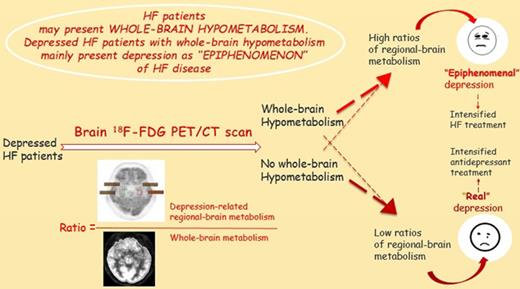-
PDF
- Split View
-
Views
-
Cite
Cite
V Lyra, J Parissis, M Kallergi, E Rizos, G Filippatos, D Kremastinos, S Chatziioannou, 18F-FDG PET/CT brain glucose metabolism as a marker of different types of depression comorbidity in chronic systolic heart failure patients, European Heart Journal, Volume 41, Issue Supplement_2, November 2020, ehaa946.1153, https://doi.org/10.1093/ehjci/ehaa946.1153
Close - Share Icon Share
Abstract
Depression comorbidity is an important issue in heart failure (HF) disease. Results from the recent prospective randomized trial MOOD-HF did not provide a rationale for the indiscriminate use of antidepressants in depressed HF patients.
The study investigated whole-brain and regional-brain glucose metabolism in HF patients with 18F-FDG PET/CT and its association with depression comorbidity.
Twenty-nine hospitalized patients with symptomatic systolic HF disease (LVEF<40%), NYHA class II-IV and mean age of 55.5±12.0 years participated in the study. All patients had echocardiography, blood sampling, HF-adapted and psychometric questionnaires before discharge and a brain 18F-FDG PET/CT scan after discharge. Semi-automated PET/CT image analysis was performed on all patients and 30 matched controls. The metabolic index SUVmean was calculated for the whole-brain and three brain regions (prefrontal cortex, amygdala and hippocampus), implicated in depression pathogenesis. A standardized SUVmean was also estimated by dividing depression-related regional-brain SUVmean with the whole-brain SUVmean.
HF patients had lower average whole-brain SUVmean (3.90±1.49 vs 5.10±1.35, p=0.001), average regional-brain SUVmean (4.57±2.31 vs 9.96±3.58, p<0.001) and average standardized SUVmean (1.28±0.60 vs 2.07±1.32, p<0.001) compared to controls.
Whole-brain SUVmean had a statistically significant correlation to patient age (r=−0.39, p=0.031), NYHA class (p=0.027), LVEF in the major group of 21 NYHA III-IV patients (p=0.018), diabetes comorbidity (p=0.001), creatinine levels (r=−0.49, p=0.005) and depression (r=−0.36, p=0.049). Regional-brain SUVmean was correlated to whole-brain SUVmean (r=0.53, p=0.002) and depression (r=0.46, p=0.011). The standardized SUVmean, in particular, was found to be a robust index that could differentiate HF patients with “epiphenomenal” (>0.93) or “real” (≤0.93) depression.
HF patients with more severe disease showed whole-brain and regional-brain hypometabolism in 18F-FDG PET/CT scan, which is consistent with impaired cerebral perfusion.
Depressed HF patients (Beck Depression Inventory score >13) exhibited different metabolic patterns that could be used to differentiate between “epiphenomenal” and “real” depression. Namely, presence of whole-brain hypometabolism suggested “epiphenomenal” depression. Absence of whole-brain hypometabolism suggested “real” depression. When the pattern of whole-brain hypometabolism included significant relative, depression-related regional hypometabolism (standardized SUVmean ≤0.93), “real” depression was the most likely diagnosis. The distinction is important, as different types of comorbid depression suggest different treatment approach.

Summarizing figure
Type of funding source: None



